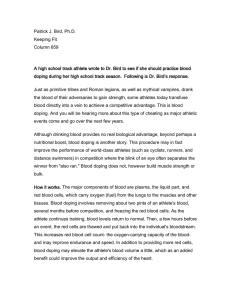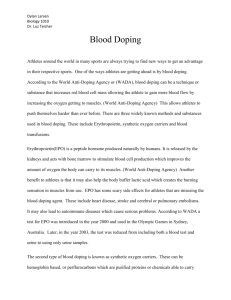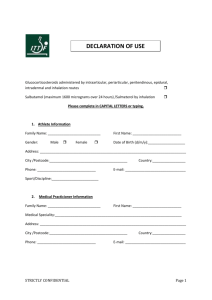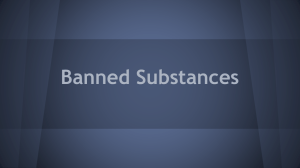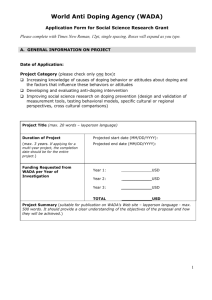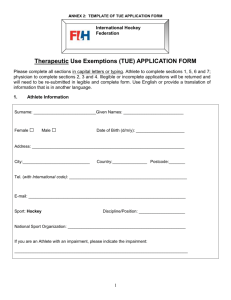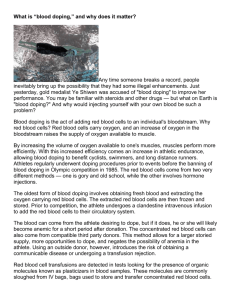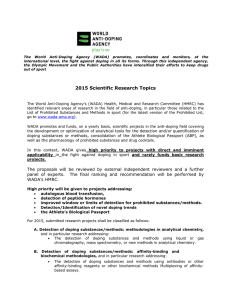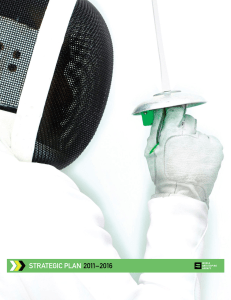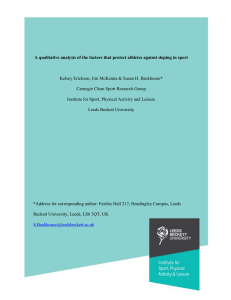Newsletter 3, March 2013 A new doping settlement? A review of the
advertisement
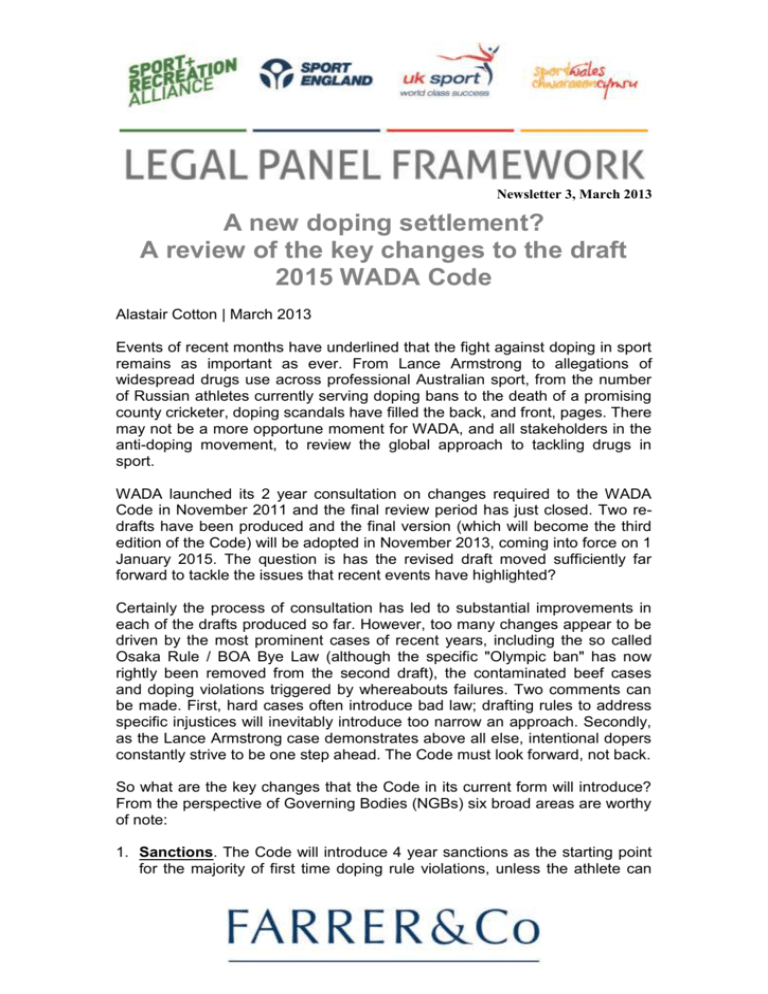
Newsletter 3, March 2013 A new doping settlement? A review of the key changes to the draft 2015 WADA Code Alastair Cotton | March 2013 Events of recent months have underlined that the fight against doping in sport remains as important as ever. From Lance Armstrong to allegations of widespread drugs use across professional Australian sport, from the number of Russian athletes currently serving doping bans to the death of a promising county cricketer, doping scandals have filled the back, and front, pages. There may not be a more opportune moment for WADA, and all stakeholders in the anti-doping movement, to review the global approach to tackling drugs in sport. WADA launched its 2 year consultation on changes required to the WADA Code in November 2011 and the final review period has just closed. Two redrafts have been produced and the final version (which will become the third edition of the Code) will be adopted in November 2013, coming into force on 1 January 2015. The question is has the revised draft moved sufficiently far forward to tackle the issues that recent events have highlighted? Certainly the process of consultation has led to substantial improvements in each of the drafts produced so far. However, too many changes appear to be driven by the most prominent cases of recent years, including the so called Osaka Rule / BOA Bye Law (although the specific "Olympic ban" has now rightly been removed from the second draft), the contaminated beef cases and doping violations triggered by whereabouts failures. Two comments can be made. First, hard cases often introduce bad law; drafting rules to address specific injustices will inevitably introduce too narrow an approach. Secondly, as the Lance Armstrong case demonstrates above all else, intentional dopers constantly strive to be one step ahead. The Code must look forward, not back. So what are the key changes that the Code in its current form will introduce? From the perspective of Governing Bodies (NGBs) six broad areas are worthy of note: 1. Sanctions. The Code will introduce 4 year sanctions as the starting point for the majority of first time doping rule violations, unless the athlete can Newsletter 3, March 2013 establish that the commission of the violation was not intentional or reckless. Previously the burden was on prosecutors to seek 4 year bans on the basis of aggravating circumstances. This was too infrequently relied on and the change in emphasis is desired by the majority of athletes. There are some concerns, however, about the current drafting and it is hoped that these can be resolved before the final draft is adopted. There is, for example, no definition, of reckless or intentional and one fears endless appeals on the point. It remains uncertain too whether the 4 year ban will withstand challenge under European law. In the 1990s the IAAF imposed 4 year bans on its athletes which were consistently challenged (most notably by Katrina Krabbe) on the grounds the ban was an unlawful penalty. 2. Performance Enhancing. For the first time it is mandatory that, to be placed on the prohibited list, a substance or method must have the potential to enhance sporting performance. It is also necessary to show that either the drug poses a health risk or violates the spirit of sport (a phrase that might still benefit clarification as to its meaning). Again this is a positive change. However, lead commentators remain concerned that the Code makes no attempt to recognise that a negligible amount of even a prohibited substance, which is scientifically proven to be incapable of enhancing performance and which was not present intentionally, should not amount to a doping violation. Athletes will be able to argue that a product consumed was contaminated, although more elaboration would be desirable to understand how this "defence" will work in practice. 3. Managing Athletes. NGBs in particular should note and inform their athletes of the following changes: (i) TUEs. The Therapeutic Use Exemption process is a means by which an athlete can obtain approval to use a prescribed prohibited substance for the treatment of a legitimate medical condition. A new provision now requires a national level athlete who becomes an international level athlete to re-apply for his/her TUE with the International Federation. There is obvious scope for confusion in this distinction and tension between the interpretation at the international and national level on the international standards for granting the TUE. (ii) Whereabouts. The filing failures / missed test rule that triggers an antidoping rule violation has been reduced from 3 missed tests in 18 months to 3 missed tests in 12 months. This will undoubtedly benefit forgetful -2- Newsletter 3, March 2013 athletes and draw the potential sting for those who inadvertently miss out of competition tests. However, in some quarters there is concern that the change will inadvertently help intentional dopers by making it easier for them to arrange their doping practices, including by evading testing, over a shorter period before the "clock" of missed tests is reset. (iii) Retirement. An athlete who retires must now spend at least 6 months on the Registered Testing Pool before he/she can return to competition. 4. Disciplinary Process. A new change in the Code may compel those (few) NGBs who have not delegated results management, including the presentation of cases to UK Anti-Doping / the National Anti-Doping Panel, to do so. The Code now imports the right to an independent and impartial tribunal from Article 6.1 of the European Convention on Human Rights. It may be that some independence from an NGB will be required in the prosecution of doping offences. 5. Amnesty. The Code introduces new provisions regarding the ability to suspend, or reduce entirely, a sanction in order to encourage athletes to provide "substantial assistance" (in short full disclosure of credible information and the willingness to provide testimony). There has been some debate about the role of amnesties in sport, and cynicism that active athletes (as opposed to athletes nearing retirement) will take such risks, but any additional intelligence that this provides must surely be welcome. 6. Athlete Support Personnel and New ADRVs. Finally, the Code, if adopted, will introduce a number of new anti-doping rule violations which focus on the athlete's support personnel, including complicity in a doping violation and prohibited association. It will be an offence for an athlete to associate with, for example, a coach or doctor who is either serving a ban or has been found guilty of a doping within the previous eight years. NGBs must impose express obligations on their own coaches, support and medical staff (for example in the licence with that person) around compliance with doping rules and specific sanctions for breaching those (and follow the lead of UKA and Team Sky by removing such persons from their staff). The majority of the changes will undoubtedly advance the ability of WADA, NADOs, IFs and NGBs to combat doping and they strengthen the anti-doping message, whilst moving towards a more just system. There are other changes in the proposed Code, not summarised above, which are also welcome, -3- Newsletter 3, March 2013 including in particular the use of athlete biological passports and the extension of the limitation period for historic offences to 8 and 14 years depending on the rule violation. However, there are of course also concerns, both in the drafting and the overall approach. For example, concerns have been raised that the changes to the Code may not comply with European data protection laws. The Article 29 Working Party (an influential group made up of representatives from each EU member state’s data protection authority, the opinions of which are often reflected in the guidance of the UK regulator, the Information Commissioner’s Office), expressed its concern that “WADA’s proposals do not strike the necessary and proportionate balance between WADA’s aims and the respect for fundamental rights” and, in particular, questioning whether athlete consent is a legitimate basis to process doping information, given that athletes effectively have no choice but to comply – a concern it has raised before but which it does not feel is addressed by the new Code. The updating of the international standards that sit alongside the Code should be watched with care too. The Code is, of course, just one tool in a successful anti-doping programme. It is hoped that as much scrutiny - and resource - is given to other, arguably more important aspects in the fight against doping. Education, and developing the right (and positive) culture is paramount (there are few changes to that part of the Code). There needs to be more intelligence-led and risk based testing, with international and national bodies routinely sharing information and collaborating (something so obviously missing in the Lance Armstrong affair). Testing must be more targeted if it is to remain effective and real harmonisation of the Code must be internationally led. The recent success of Interpol in football corruption makes the point, as do the fruits of UKAD's work with UK law enforcement agencies (in the Ian Burns case for example). Positive developments in these areas would be equally welcome, to sit alongside the proposed changes to the Code. If you require further information on anything covered in this briefing please contact Alastair Cotton alastair.cotton@farrer.co.uk, 020 3375 7112) or your usual contact at Farrer & Co LLP on 20 3375 7000. -4-
